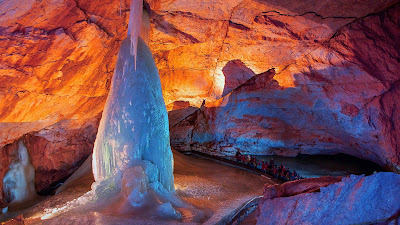 The Hallstatt Limestone is the world's richest Triassic ammonite unit, yielding specimens of more than 500 ammonite species.
The Hallstatt Limestone is the world's richest Triassic ammonite unit, yielding specimens of more than 500 ammonite species.Along with diversified cephalopod fauna — orthoceratids, nautiloids, ammonoids — we also see gastropods, bivalves, especially the late Triassic pteriid bivalve Halobia (the halobiids), brachiopods, crinoids and a few corals. We also see a lovely selection of microfauna represented.
For microfauna, we see conodonts, foraminifera, sponge spicules, radiolaria, floating crinoids and holothurian sclerites — polyp-like, soft-bodied invertebrate echinozoans often referred to as sea cucumbers because of their similarities in size, elongate shape, and tough skin over a soft interior.
Franz von Hauer’s exhaustive 1846 tome describing Hallstatt ammonites inspired renowned Austrian geologist Eduard Suess’s detailed study of the area’s Mesozoic history. That work was instrumental in Suess being the first person to recognize the former existence of the Tethys Sea, which he named in 1893 after the sister of Oceanus, the Greek god of the ocean.
As part of the Northern Limestone Alps, the Dachstein rock mass, or Hoher Dachstein, is one of the large karstic mountains of Austria and the second-highest mountain in the Northern Limestone Alps. It borders Upper Austria and Styria in central Austria and is the highest point in each of those states.
Parts of the massif also lie in the state of Salzburg, leading to the mountain being referred to as the Drei-Länder-Berg or three-state mountain. Seen from the north, the Dachstein massif is dominated by the glaciers with the rocky summits rising beyond them. By contrast, to the south, the mountain drops almost vertically to the valley floor. The karst limestones and dolomites were deposited in our Mesozoic seas. The geology of the Dachstein massif is dominated by the Dachstein-Kalk Formation — the Dachstein limestone — which dates back to the Triassic.
There were several phases of mountain building in this part of the world pushing the limestone deposits 3,000 metres above current sea level. The rock strata were originally deposited horizontally, then shifted, broken up and reshaped by the erosive forces of ice ages and erosion.
The Hallstatt mine exploits a Permian salt diapir that makes up some of this area’s oldest rock.
The salt accumulated by evaporation in the newly opened, and hence shallow, Hallstatt-Meliata Ocean. This was one of several small ocean basins that formed in what is now Europe during the late Paleozoic and early Mesozoic when the world’s landmasses were welded together to form the supercontinent Pangea.
Pangea was shaped like a crescent moon that cradled the famous Tethys Sea. Subduction of Tethyian oceanic crust caused several slivers of continental crust to separate from Pangea, forming new “back-arc basins” (small oceans formed by rifting that is associated with nearby subduction) between the supercontinent and the newly rifted ribbon continents.
The Hallstatt-Meliata Ocean was one such back-arc basin. As it continued to expand and deepen during the Triassic, evaporation ceased and reefs flourished; thick limestone deposits accumulated atop the salt. When the Hallstatt-Meliata Ocean closed in the Late Jurassic, the compression squeezed the low-density salt into a diapir that rose buoyantly, injecting itself into the Triassic limestones above.
The Hallstatt salt diapir and its overlying limestone cap came to rest in their present position in the northern Austrian Alps when they were shoved northward as nappes (thrust sheets) during two separate collision events, one in the Cretaceous and one in the Eocene, that created the modern Alps. It is from the Hallstatt salt diapir that Hallstatt, like so many cities and towns, gets its name.
Deposits of rock salt or halite, the mineral name of sodium chloride with the chemical formula of NaCl, are found and mined around the globe. These deposits mark the dried remains of ancient oceans and seas.
Names of rivers, towns and cities in Europe — Salzburg, Halle, Hallstatt, Hallein, La Salle, Moselle — all pay homage to their connection to halite and salt production. The Greek word for salt is hals and the Latin is sal. The Turkish name for salt is Tuz, which we see in the naming of Tuzla, a salt-producing region of northeastern Bosnia-Herzegovina and in the names of towns that dot the coast of Turkey where it meets the Black Sea. Hallstatt with its salt diapir is no exception.
The salt-named town of Hallstatt sits on the shores of the idyllic Hallstätter Sea at the base of the Dachstein massif. Visiting it today, you experience a quaint traditional fishing village built in the typical upper Austrian style. Tourism drives the economy as much as salt as this area of the world is picture-perfect from every angle—including the fossils.




Comments